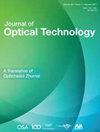Radiation source with enhanced virucide effectiveness based on a mixture of helium and iodine vapor
IF 0.6
4区 物理与天体物理
Q4 OPTICS
引用次数: 0
Abstract
Subject of study. A source of spontaneous emission (a lamp) in the ultraviolet spectral range excited by a capacitive discharge was investigated. Iodine vapor and mixtures of iodine vapor with inert gases were used as the operating gas medium of the lamp. Conditions for enhancements in specific output parameters of the lamp emission were investigated. Excitation conditions under which the lamp emits predominantly at the iodine atomic line with a wavelength of 206.16 nm were determined. Aim of study. The primary aim of the study was to investigate the spectral and energy characteristics of the lamp based on the iodine vapor, which is promising for the development of a radiation source with enhanced virucidal effectiveness for ultraviolet disinfection of a human environment contaminated with pathogenic microorganisms including severe acute respiratory syndrome coronavirus 2 (SARSCoV-2). Method. In this study, the composition and pressure of the operating medium were optimized. In addition, the excitation mode of the lamp emission was optimized by changing the repetition rate of voltage pulses. Main results. At a specific excitation power of approximately 1.3 mW/cm3 and partial pressures of iodine vapor and helium of approximately 2.5 and 7 Torr, respectively, the line of an iodine atom with a wavelength of 206.16 nm dominates in the output lamp spectrum, and the specific emission power at the outer surface of the lamp tube is approximately 3 mW/cm2. Practical significance. The emission of the investigated lamp is in the spectral range of 200–225 nm, which is promising in terms of developing technology for safe ultraviolet inactivation of pathogenic microorganisms including SARS-CoV-2. © 2022 Optica Publishing Group.基于氦和碘蒸气混合物的具有增强杀毒效果的辐射源
研究对象。研究了由电容放电激发的紫外光谱范围内的自发发射源(灯)。使用碘蒸气和碘蒸气与惰性气体的混合物作为灯的操作气体介质。研究了提高灯发射的特定输出参数的条件。确定了灯主要在波长为206.16nm的碘原子线上发射的激发条件。研究目的。该研究的主要目的是研究基于碘蒸气的灯的光谱和能量特性,这有助于开发一种具有增强杀病毒效果的辐射源,用于紫外线消毒被病原微生物污染的人类环境,包括严重急性呼吸综合征冠状病毒2型(SARSCoV-2)。方法在本研究中,对操作介质的组成和压力进行了优化。此外,通过改变电压脉冲的重复频率来优化灯发射的激励模式。主要结果。在约1.3mW/cm3的比激发功率和约2.5和7Torr的碘蒸气和氦的分压下,具有206.16nm波长的碘原子的线在输出灯光谱中占主导地位,并且在灯管的外表面处的比发射功率约为3mW/cm2。实际意义。所研究的灯的发射光谱范围为200–225 nm,这在开发包括严重急性呼吸系统综合征冠状病毒2型在内的病原微生物的安全紫外线灭活技术方面很有前景。©2022 Optica出版集团。
本文章由计算机程序翻译,如有差异,请以英文原文为准。
求助全文
约1分钟内获得全文
求助全文
来源期刊
CiteScore
0.90
自引率
25.00%
发文量
66
审稿时长
3-8 weeks
期刊介绍:
The journal publishes design details of a diversity of optical instruments, along with a strong section on computational optics useful to engineers, mathematicians, and physicists, as well as optical scientists. Issues of the English translation volume are published by OSA and appear at the same time as the Russian language edition, Opticheskii Zhurnal, which is produced by the Vavilov State Optical Institute

 求助内容:
求助内容: 应助结果提醒方式:
应助结果提醒方式:


